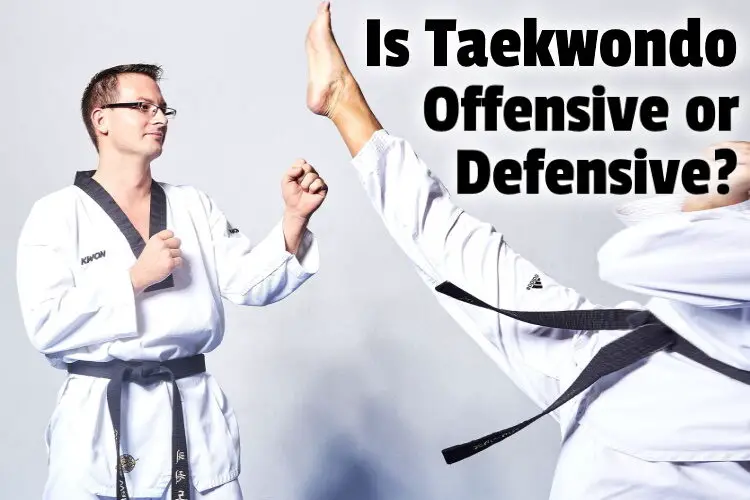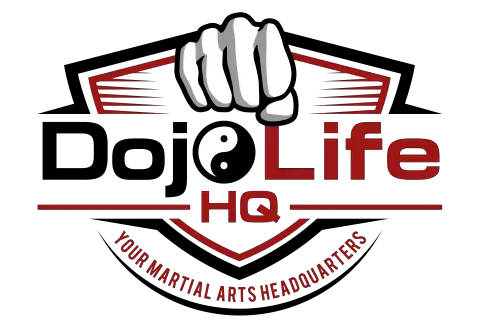Taekwondo is one of the most popular martial arts out there. It involves a lot of kicking. But is Taekwondo offensive or defensive?
Taekwondo is largely defensive in that it is not designed for attack. Most martial arts have a spiritual component that decries unnecessary use of force and the most offensive or aggressive systems, such as Muay Thai, Kickboxing, or Krav Maga, typically lack such a component.
But there’s a lot more to know.
In this article, we’ll explore whether TKD is ever aggressive or violent and if it’s useful in a real fight. But we will also check out why it sometimes gets a bad reputation.
Let the fun begin.

Is Taekwondo aggressive or violent?
Taekwondo, like most other eastern martial arts, is not inherently aggressive or violent. Taekwondo is about self-discipline, character-building, and respect. It is a mix of sport, self-defense, and spiritual refinement.
Having said that, the truth is that any practitioner can ignore its more philosophical and spiritual dimension and focus strictly on the self-defense facet.
This could also happen if they have attended a dojo where the aspect has been deliberately disregarded. In that case, the Taekwondo practitioner could be aggressive.
It’s good to remember that TKD, like most martial arts, was originally designed for combat against oppressors.
Naturally, they can be aggressive or violent if the situation demands it.
If you’d be using it in competitions, there are rules in place to ensure that practitioners do not become violent.
Say you’ve decided to learn TKD, how often should you train?
Luckily, this is what I looked at in a recent article. In it, I shared how many days a week you should train and how long it takes to progress in it. But I also spoke about whether it’s cool to train every day.
Just click the link to read it on my site.
Watch a Real Full Contact Professional Taekwondo Fight Video http://t.co/GwHt0dzlDp pic.twitter.com/sV32EXT3KJ
— Ava Crummer (@Racturemer) October 10, 2015
Is Taekwondo useful in a real fight?
Taekwondo is useful in a real fight. One learns how to kick, punch, strike, block, and utilize other fighting techniques. And the conditioning that results from training regularly makes one fitter than most people.
So while it may not be the ideal martial art if self-defense is the primary goal, knowing any amount of any martial art is better than none.
TKD can be a deadly martial art, depending on how skilled the practitioner is.
It consists mainly of kicking, and when properly executed, could incapacitate one’s opponent seeing as there are no rules in a real fight.
A strong kick to a vulnerable part of an opponent’s body can be deadly. And, TKD practitioners are usually fast. This could give them an edge in a real fight where every second counts.
In fact, TKD equips practitioners with highly useful skills that include punching and striking.
In a hypothetical fight, a TKD fighter may not find it easy if their assailant is a trained fighter because both parties can render the other’s attacks largely ineffective by employing great defensive moves.
But if the assailant is not trained (the more likely possibility considering the fact that most people are not trained fighters), they are likely to be trounced by the TKD fighter.
They won’t be prepared for the strikes, punches, kicks that an adept TKD fighter can unleash. They’d also be stunned by the speed at which all these are coming at them!
Most untrained people naturally use basic boxing moves when they’re about to fight.
A Taekwondo practitioner, as an example, could lure them into thinking that boxing is what’s going to transpire. They could exchange a few punches and then suddenly unleash one or two deadly kicks.
TKD is useful in a real fight, but I’d argue that other martial arts that are more focused on self-defense are a lot better.
#Taekwondo‘s #Olympics-led rule changes sacrifice tradition for entertainment: https://t.co/RYOklTRhSk pic.twitter.com/RQ9cQsymeG
— ChampionsWay (@championsway) July 7, 2016
Why does TKD get a bad reputation?
TKD gets a bad reputation because many believe that it has lost its edge as a combat sport and is now an ineffective and bland Olympic sport or game. But many also criticize how quickly some schools award black belts.
In other words, it may not work as an effective self-defense art, and that is especially true if someone got their black belt in just 2-3 years.
In its early days in Korea, TKD was employed for combat and was naturally used by the military. In such scenarios, the intent was to maim or even kill an opponent.
But as an Olympic sport now, it is naturally constrained by rules, while real fights have no such constraints. A lot of people believe that some of these rules would have miseducated a TKD practitioner, especially if they have internalized them.
In an Olympic contest or one that follows the rules, the practitioners are extremely careful, as the goal is not to harm the other party.
This kind of training is what could get one killed in a real fight, some people argue.
They also say that unless there’s a reasonable distance between the TKD practitioner and the street fighter, the former may not even be able to use the lethal licking techniques they have learned.
But a highly proficient Taekwondo practitioner can also leverage kicks as a way to keep an assailant from even getting close in the first place.
So, you’re interested in learning TKD, but can you teach yourself?
In a recent article of mine, I revealed whether it’s easy to learn and if you can learn it online. But I also shared how to learn it step-by-step completely for free!
Just click the link to read it on my site.
What matters most is how well you walk through fire 🔥— Bukowski
•
•
•#taekwondo #fire #euforia #scream #celebra #fita #tkdgirl #fightlikeagirl #italiana #atleta
•
•
•@taekwondofita @ItaliaTeam_it pic.twitter.com/QeQDIfYnH9— Pau Armería Vecchi (@pau_armeria) January 20, 2021
Why do they scream in Taekwondo?
Practitioners scream in Taekwondo as a way to generate extra power. Shouting compels them to exhale and inhale more intensely, adding extra intensity to their kicks, punches, and strikes. They also signal to the judges when a target has been hit.
This scream is called Kihap in TKD.
It’s a combination of two words: Ki and hap. The first refers to energy or life force, while the other means to coordinate. So, the scream is a way to coordinate one’s energy.
What happens is that intra-abdominal pressure is created using the diaphragm.
This stabilizes the core, the spine and focuses the joints. That way, the fighter is in a better position to strike. It’s also a way to psyche themselves up.
What about Aikido vs. Taekwondo, which one’s better?
That’s the theme of a recent article where I looked at the differences between both of them and why Aikido has a bad reputation. But I also looked at how Aikido compares with BJJ.
Just click the link to read it on my site.
Do you like this 📸? #martialsrts #PhotoOfTheNight #taekwondo #art #Muaythai #life #moon #photography #photooftheday pic.twitter.com/5a9WykAdtK
— Jesús Enrique (@Jesus_enrique75) November 25, 2017
Which martial arts are defensive or offensive?
Martial arts such as Muay Thai, Brazilian Jiu-Jitsu, Ninjutsu, Bacom, and Krav Maga are considered to be more offensive, while Aikido and Tai Chi are examples of martial arts that are less used offensively with an overall more peaceful ethos.
Having said that, the reality is that there’s no martial art that’s solely defensive or offensive.
All martial arts (even Tai Chi) contain elements of both, as they should.
After all, they’re fighting systems. And a good fighting system entails both defensive and offensive techniques. But some are more focused on aggressive and offensive approaches than others.
Aikido and Judo, for example, are more about leveraging the attacker’s energy and momentum against them and not about directly trying to harm them. In fact, Judo actually means “gentle way”. This is not to suggest that it’s in any way ineffective!
Suppose you have to choose between Taekwondo and Judo, which one’s better?
In a recent article, I looked at the main similarities between both of them and whether Taekwondo is effective in a street fight. But I also spoke about who’s likely to win if a Taekwondo practitioner and a Judoka were to have a go at it.
Just click the link to read it on my website.
Conclusion
In the article, we explored whether TKD is aggressive or violent.
And we looked at if Taekwondo is useful in a real fight. But we also checked out why it gets a bad reputation. Then, we looked at why Taekwondo practitioners scream.
Lastly, we wrapped things up by looking at which martial arts are defensive or offensive.
Image by Taekwondo-am-Tegernsee from Pixabay
